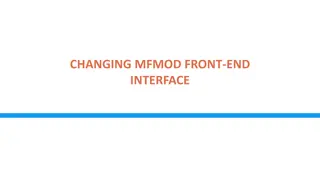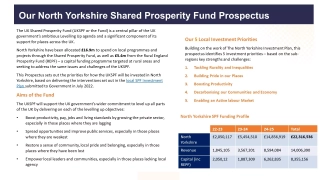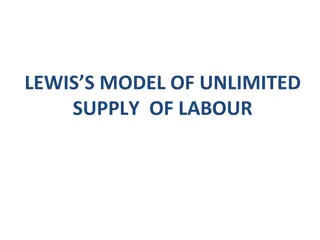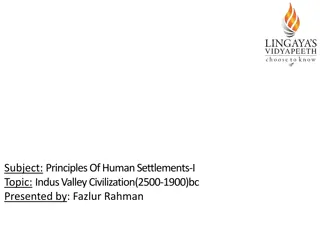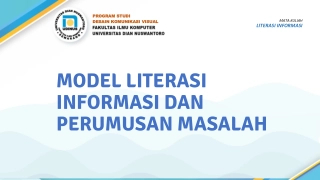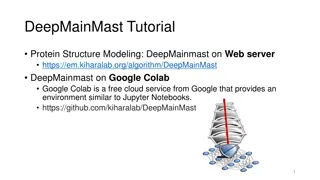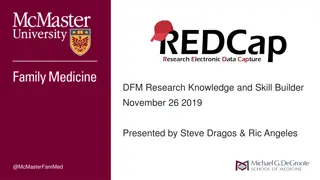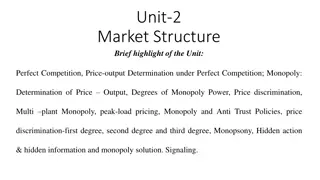Building a Macrostructural Standalone Model for North Macedonia: Model Overview and Features
This project focuses on building a macrostructural standalone model for the economy of North Macedonia. The model layout includes a system overview, theory, functional forms, and features of the MFMSA_MKD. It covers various aspects such as the National Income Account, Fiscal Account, External Account, Monetary policy, and International linkages. The model incorporates statistical relationships and economic theories to provide a comprehensive representation of the economy. Utilizing behavioral equations and error-correction models, it aims to analyze long-run and short-run dynamics, equilibrium mechanisms, and output gaps. With an easy-to-use Excel interface, it connects with the Eviews-enabled backend for data analysis.
Download Presentation
Please find below an Image/Link to download the presentation.
The content on the website is provided AS IS for your information and personal use only. It may not be sold, licensed, or shared on other websites without obtaining consent from the author. Download presentation by click this link. If you encounter any issues during the download, it is possible that the publisher has removed the file from their server.
Presentation Transcript
BUILDING A MACROSTRUCTURAL STANDALONE MODEL FOR NORTH MACEDONIA: MODEL LAYOUT
Contents 1. MFMOD System Overview 2. Model Layout: Theory and Functional Forms a. Potential Output b. NIA-Expenditure Account c. NIA-Production Account d. Fiscal : Federal, Provincial, Local e. Balance of Payments : Current Account, Capital & Financial Account, Reserve Assets f. Labor and Monetary Market g. International Linkages: Trades, Remittances, Tourism, Commodity Prices 2
Features of MFMSA_MKD Bringing in both statistical relationships and economic theories covered in the general macro sessions to build a macro-structural model for the N. Macedonia s economy (MFMSA_MKD): A whole-economy, national representation covers the four main macroeconomic accounts: National Income Account: 3 approaches (Expenditure, Production, Income); 3 units (current, real, deflators). Fiscal Account (federal/provincial/local): revenues, expenditures, debt, fiscal financing. External Account: current, capital, financial account; reserves. Monetary: policy interest rate, money supply. International linkages: trade, commodities, remittances, tourism. General equilibrium in nature: MFMSA_MKD tracks the flows of funds in the economy: supply and demand of factors of production. Long-run vs. short-run dynamics. Model equilibriummechanisms: Error-Correction Terms in many equations; speed of adjustments mostly econometrically determined via historical data Output gap: works through prices. 3
Features of MFMSA_MKD Most behavioral equations are estimated using error-correction models (ECM); some others as historical shares Theory determines functional form: - Firms optimization program for investment and labor demand - Permanent income hypothesis for private consumption - CES for imports and exports - New Keynesian Philips curve for both prices and wages - UIP+PPP for exchange rates (if floating regime). - Taylor rule for monetary policy 4
A SIMPLIFIED ECONOMIC MAP OF MFMSA_MKD DEMAND DOMESTIC SUPPLY Taxes and transfers Investment Income Participation rate GDP / Demand Prices and interest rates Consumption Productivity Labor force PRICES Productivity Trade partners Exports Tourism Commodity prices Imports Remittances Transfers Expenditures EXTERNAL Rebates Taxes POLICIES
Features of MFMSA_MKD An easy-to-use Excel interface connects all Eviews-enabled backend of MFMSA_MKD Central Database National Sources Identiti es Equati ons Model (Accou nting/ Quasi-) WDI/WEO COMTRADE/ILO/GTAP 6
2a. Potential Output Potential Output Production Function Uses Standard Cobb-Douglas Form ????????? ?????? = ?? Total Factor Productivity Capital Stock Labor Force ? ? ????= ?? ?? ? ?? ? Participation Rate = (1 ?? ) Working Age Population (15+) Productivity ? = ?.? (2011-2022 historical average of Compensation of Employees as % nominal GDP from GDP-Income Approach) ? ??????? ????? : adjusted Perpetual Inventory Method 7
2b. Expenditure Account Summary Government Consumption Public Investment Household Consumption Private Investment KN = Federal KN + SOE KN KN = Non-Federal KN SOE KN KN: KN = CN / XN (+): real disposal income (wages, PIT, subsidies, transfers, remittances) (-): real interest rate Federal KN = Federal CN/ Federal SOE KN = Share * Non-Federal KN Non-Federal KN: XN: (+1) Operating Surplus (proxied by GDP) (+) Household consumption price, Lagged value (-) Relative price differential between Capital Rental Rate vs. Non-Federal Investment Cost XN = Public CN/Public KN Federal XN / Non- Federal XN : (+) GDP at Factor Cost deflator, Lagged Value XN: CN: (+): GDP at Factor Cost and Import deflators (+): VAT & Excise Tax Rates (+): Public Wages, GNFS Expenditure, Recurrent Social Service Grants XN/ Non-Federal XN (+): GDP at Factor Cost and Import deflators CN = Federal CN + SOE CN Federal CN: (+) Capital Investment & Capital Grants SOE CN = Non-Federal CN Private CN Private CN/Non- Federal CN CN = KN * XN CN = KN * XN Behavioral variables: Error Correction Model (ECM) Quasi-identities: Quasi-identity (DUMH) Identities: Accounting Identity 8
2b. Expenditure Account Summary Imports Statistical Discrepancies Service Exports Merchandise Exports Change in Inventories (Merchandise & Services) KN: KN: KN: (+): Domestic Demand (+): World Demand (+): World Demand Fully exogenous (-): Merchandise Export Price vs. Effective World Prices Fully exogenous (-): Service Export Price vs. Effective Domestic Price (-) Relative Price (Import price vs. Effective Domestic Price) MRCH XN: XN: Behavioral variables: Error Correction Model (ECM) Quasi-identities: Quasi-identity (DUMH) Identities: Accounting Identity XN: (+) Private Consumption deflator, Effective World Commodity Prices (+) GDP Factor Cost Deflator and Effective World Prices (+) Effective Domestic Price , Lagged Value SRVC XN: CN = KN * XN CN = KN * XN (+) GDP at Factor Cost & Lagged Value CN = KN * XN 9
2b. Expenditure Account Household Consumption Volume Economic theory: Final Household Consumption equation is derived to be consistent with the permanent income hypothesis, where consumption responds to changes in real income (post-tax wages, remittance inflows, subsidies). Long-run: consumption is fixed as a ratio to the real income of household Short-run: contemporaneous real income and policy interest rate (saving vs. consuming decision) Optimization problem: ?+? ?,? ? ? ? ?? ?+? ?? + ?? ?? ? ????? ? + ?? ????? ?+ ?? ? ?? ???+? ? ? = ?? ?=? ??? {??,??,??+?} + ?? ? ?? Regression equation: follows Mankiw and Ball (1989) Euler condition ?? ??? 1+ ??? 1 ?? 1 ??????? 2 ?? 1 ???+ ??? ?? ??????? 1 ?? = ? ? ?? 1 ??? (1 ?)?? + ? ?? + ? ?? + ?(?? ? ? ? ? ? ????) +?? 10
2c. Production Account Summary Agriculture Services Industry Net Taxes on Production KN: KN: Fully exogenous KN = GDP at Factor Cost Agriculture - Industry Lagged value, simulated demand Lagged value, simulated demand Behavioral variables: Error Correction Model (ECM) Quasi-identities: Quasi- identity (DUMH) Identities: Accounting Identity XN: XN: CN = GDP at Factor Cost Agriculture - Industry GDP at Factor Cost deflator, lagged value GDP at Factor Cost deflator, lagged value XN = CN / KN CN = KN * XN CN = KN * XN 11
2c. Production Account Summary Service subsectors (except Arts & Recreation) Agriculture Industry sub-sectors KN: KN: KN: Lagged value, simulated demand Lagged value, demand Lagged value, simulated demand Arts & Recreation KN = Service KN Other Sectors KN XN: XN: XN: GDP at Factor Cost deflator, lagged value GDP at Factor Cost deflator, lagged value GDP at Factor Cost deflator, lagged value Arts & Recreation XN = Arts & Recreation CN/Arts & Recreation KN CN = KN * XN CN = KN * XN CN = KN * XN Arts & Recreation CN = Services CN Other Sectors CN Behavioral variables: Error Correction Model (ECM) Quasi-identities: Quasi-identity (DUMH) Identities: Accounting Identity 12
2d. Fiscal Account Revenue Tax revenue Tax base Tax rate ??? ??= ??? ??? ??= ??? ???? ?????? ?????? ?? ??? ??= ??? ??? ??? ???????? ? ???? ?? ?????? ????? ?? ??? ? = ???? ????? ????? 13
2d. Fiscal Account Revenue Other Federal Govt. Revenue Tax Revenue Grants Non-Tax Revenues Total Federal Revenues Proxy Tax Bases: Proxy Tax Base: nominal GDP Proxy Tax Base: nominal GDP at Market Prices VAT / Excise: Private + Government Consumption PIT/Social contribution: total wage bill CIT: operating surplus Trade: Exports/Imports Other sales: GDP Proxy Tax Base: nominal GDP Effective Tax Rate: calculated from historical data Effective Tax Rate: average GDP share calculated from historical data Effective Tax Rate: calculated from historical data Effective Tax Rate: historical data (Oil Revenue/nominal Oil Value-Added) ??????????? = ???????? * ???????? 1 + ?? ??????????? /???? = Share + Trend + ?? ??????????? = ???????? * ???????? 1 + ?? ??????????? = ???????? * ???????? 1 + ?? 14
2d. Fiscal Account Expenditure Current Expenditure (exld. Interest Payment) Other Expenditure Interest Payment Capital Expenditure Total Expenditure GDP at Market Prices, Lagged Value Split to External & Domestic Interest Payment 1) Expenditure on Goods and Services Historical GDP Shares 2) Compensations of Employees 3) Expenditure on Goods and Services ???? = ????? ???? 1 ????? = ??? ?? ???? + ???? ??????? GDP at Market Prices/Wage Bill, Lagged Value Domestic: Policy Rate External: US Policy Rate 15
2d. Fiscal Account Financing Overall Balance = Total Revenue Total Expenditure Financing Requirement = - (Adjusted Budget Balance) = - (Overall Actual Balance + Fiscal Statistical Discrepancies) Financing Sources = External Financing + Domestic Financing = External_Share* Financing Requirement + (1-External_Share)* Financing Requirement Financing Gap = Financing Requirement Financing Sources Total Debt = External Debt + Domestic Debt External Debt = External Debt(-1) + External Financing External Amortization + External Debt Evaluation Domestic Debt = Domestic Debt(-1) + Domestic Financing Domestic Amortization + Domestic Debt Evaluation 16
2e. Balance of Payments Primary & Secondary Income Credit Primary & Secondary Income Debit GNFS Exports GNFS Imports Current Account Balance GNFS Exports: determined by NIA - Exports (CN) & EXR GNFS Imports: determined by NIA - Imports (CN) & EXR Remittance Outflow: domestic GDP, lagged value Behavioral variables: Error Correction Model (ECM) Quasi-identities: Quasi- identity (DUMH) Identities: Accounting Identity Behavioral: historical trend Remittance Inflows: partner GDP (nominal) Non-Oil Merchandise Exports: determined by Non-Oil Exports in NIA (CN) & EXR Merchandise Imports: Domestic Demand, EXR External Debt Payment by Government: linked to External Debt Payment in Fiscal Other Exports: domestic GDP Services Exports: residual = GNFS Merchandise Oil Export: determined by NIA Oil Exports Other Outflows: historical GDP trend Services Exports: residual = GNFS - Merchandise 17
2e. Balance of Payments Primary & Secondary Income Credit Primary & Secondary Income Debit GNFS Exports GNFS Imports Current Account Balance Behavioral variables: Error Correction Model (ECM) Quasi-identities: Quasi- identity (DUMH) Identities: Accounting Identity Behavioral: historical trend Merchandise/Service Exports: determined by NIA - Exports (CN) & EXR External Debt Payment by Government: linked to External Debt Payment in Fiscal Merchandise/Service Imports: determined by NIA - Imports (CN) & EXR Remittance Inflows: partner GDP (nominal) Merchandise/Service disaggregation: historical GDP shares, growth index Merchandise/Service disaggregation: historical GDP shares, growth index Other Outflows: historical GDP trend Other Exports: domestic GDP TOP DOWN approach 1 component has to be residual TOP DOWN approach 1 component has to be residual 18
2e. Balance of Payments Capital Account Portfolio Investment FDI Other Investment Other Investment Net Flows; Historical GDP Share Historical GDP Share Historical GDP Share Fully exogenous Total BOP Balance = Capital Account Financial Account + Current Account + Net Error and Emissions (BPM 6) = Change in Reserve Assets Stock of Reserves = Stock of Reserve (-1) + Change in Reserve Assets Government External Financing = - Fiscal External Financing Behavioral variables: Error Correction Model (ECM) Quasi-identities: Quasi-identity (DUMH) Identities: Accounting Identity Behavioral: historical trend 19
2f. Labor and Monetary Market Nominal wages grow in line with the marginal product of labor and prices In the short-run, it aims to close the gap between unemployment and the structural unemployment rate It is assumed that labor supply (????? ????15+) is fixed and inelastic to income net of taxes ? ???+ ( ?? ?? + ?1???? ???? ) ??= ? + ? ?? 1 ???? 1 ?? 1 + ? ?? 1+ 1 ? ???? ??????? ??? 20
2f. Labor and Monetary Market Equilibrium labor demand is determined by producer real wages adjusted for productivity growth. In the short run, the wage-price differential will lower demand for labor. The firm wants to hire labor where wages do not exceed marginal costs. The change in the output gap measures the degree to which temporary or short-term workers fill in excess demand by firms to manage production over the economic cycle. ?? ?? ?? ?? ??= ?1?? 1 ?? 1 + ?2 ?????+ ?2 log log + ?? 21
2f. Labor and Monetary Market For policy interest rate: Taylor rule ??= ??? 1+ (1 ?) ??+ ? + ?1??? ? + ?2?? ? + ? + ??? Real Money Supply:= F(GDP, policy interest rate, velocity) Nominal Money Supply = Real Money Supply * Private Consumption Deflator Reserve Money = Nominal Money Supply / Money Multiplier (monitor Money Multiplier fully exog.) Net Foreign Asset = - Change in Reserve Assets (from BOP) Net Domestic Assets = Reserve Money Net Foreign Asset Central Bank = Net Domestic Assets Deposit Money Banks (fully exog.) 22
2g. International Linkages In the current, N. Macedonia is connected to the world through: - Trade channel: rescaled to top 5 importing partners Export markets: Trade weights are calculated from N. Macedonia s bilateral exports data, averaging 2015- 19. Effective exchange rates - Commodity channel: Commodity and Manufacturing Unit Prices are taken from the World Bank s Global Commodity Outlook - Tourism channel: - Remittance channel: rescaled to top 10 sender countries Remittance Inflows: Use the World Bank s Remittance and Migration Matrix 2018 23











